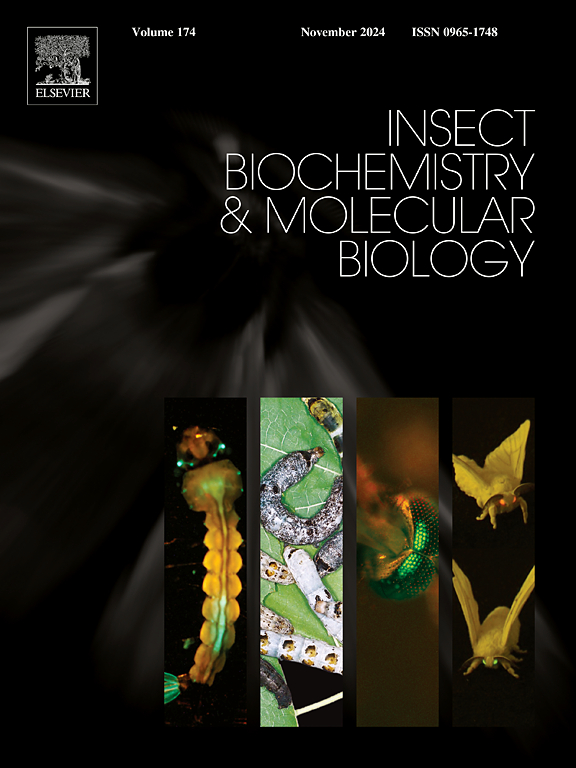Osmoregulation by sucrose isomerization in the phloem-feeding whitefly Bemisia tabaci involves members of the glycoside hydrolase family 13
IF 3.2
2区 农林科学
Q2 BIOCHEMISTRY & MOLECULAR BIOLOGY
引用次数: 0
Abstract
A phloem-sap based diet requires unique enzymatic skills for regulating the osmotic pressure differences in the gut lumen between the sucrose-rich ingested sap and the body fluids, which can lead to desiccation and death. In the phloem-feeding whitefly Bemisia tabaci, members of the glycoside hydrolase family 13 (GH13) are likely to play a critical role in mitigating this risk by oligomerizing and isomerizing the products of sucrose hydrolysis. So far, however, the identities of the family members acting as sucrose isomerases (mainly isomerizing trehalulose) remain unknown. In this study, we focused on four putative sucrose isomerase coding genes of B. tabaci that belong to the GH13 family. The four coding genes were selected based on their phylogeny, expression patterns, and motif analyses. We used artificial diets of sucrose and dsRNA to knockdown the expression of each of the target genes and analyzed the sugar composition of the secreted honeydew. We found that in all cases, gene silencing resulted in a significant reduction of the fractions of trehalulose accompanied by an increase in the fractions of the trisaccharide melezitose, suggesting that the insects attempt to compensate for the inability to isomerize sucrose by synthesizing oligosaccharides. In addition, we found that the downregulation of the target genes also resulted in a significant increase in the mortality rates of the silenced insects and a significant delay in the development of their progeny. Taken together, these findings demonstrate the importance of the osmoregulation-by-isomerization strategy in B. tabaci.

食性烟粉虱韧皮部蔗糖异构化的渗透调节涉及糖苷水解酶家族成员13。
以韧皮部汁液为基础的饮食需要独特的酶促技能来调节肠道内富含蔗糖的汁液和体液之间的渗透压差,这可能导致干燥和死亡。在以韧皮部为食的粉虱中,糖苷水解酶家族13 (GH13)的成员可能通过寡聚和异构化蔗糖水解产物,在减轻这种风险方面发挥关键作用。然而,到目前为止,作为蔗糖异构酶(主要是海藻糖异构化)的家族成员的身份仍然未知。在这项研究中,我们重点研究了4个被推测属于GH13家族的烟粉虱蔗糖异构酶编码基因。这4个编码基因是根据它们的系统发育、表达模式和基序分析筛选出的。我们使用蔗糖和dsRNA的人工饲料来敲低每个目标基因的表达,并分析分泌的蜜瓜的糖成分。我们发现,在所有情况下,基因沉默导致海藻糖的含量显著减少,同时三糖melezitose的含量增加,这表明昆虫试图通过合成低聚糖来弥补无法异构化蔗糖的缺陷。此外,我们发现靶基因的下调也会导致沉默昆虫死亡率的显著增加和后代发育的显著延迟。综上所述,这些发现证明了烟粉虱异构化渗透调节策略的重要性。
本文章由计算机程序翻译,如有差异,请以英文原文为准。
求助全文
约1分钟内获得全文
求助全文
来源期刊
CiteScore
7.40
自引率
5.30%
发文量
105
审稿时长
40 days
期刊介绍:
This international journal publishes original contributions and mini-reviews in the fields of insect biochemistry and insect molecular biology. Main areas of interest are neurochemistry, hormone and pheromone biochemistry, enzymes and metabolism, hormone action and gene regulation, gene characterization and structure, pharmacology, immunology and cell and tissue culture. Papers on the biochemistry and molecular biology of other groups of arthropods are published if of general interest to the readership. Technique papers will be considered for publication if they significantly advance the field of insect biochemistry and molecular biology in the opinion of the Editors and Editorial Board.

 求助内容:
求助内容: 应助结果提醒方式:
应助结果提醒方式:


